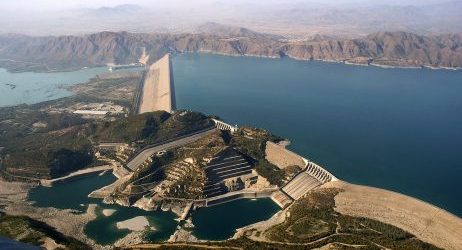In August 2018, seated behind a large desk and looking straight into the camera for his inaugural address, Prime Minister Imran Khan declared that building dams was the only way to tackle Pakistan’s existential water problems.
Fast forward a few years and the Water and Power Development Authority (WAPDA) has started construction on two major hydroelectric projects: Mohmand in Khyber Pakhtunkhwa and Diamer-Bhasha in Gilgit-Balististan. The latter, a 272-meter behemoth, is billed as the highest roller compacted dam in the world. With a storage capacity of 8.1 million-acre-feet, it’s also touted as a silver bullet for Pakistan’s water crisis.
On the face of it, dams seem to make imminent sense for Pakistan, where a water-intensive agricultural sector employs nearly half the workforce. With reports warning that the country could “run dry” by 2025, an increase in storage capacity should, in theory, increase the availability of freshwater during droughts.
Pakistan’s two largest dams – Tarbela and Mangla – are seasonal regulators, explained Mustafa. They are filled during the monsoon season and drained during the dry winter months for crop production. This means that while Diamer-Bhasha may increase storage capacity in the Indus Basin seasonally, it won’t create a perennial reserve of water to draw on during lean years.
Then there is the price tag to consider. Pakistan has struggled to secure funds for the Diamer-Bhasha dam for years. The project was initially green-lit by President Pervez Musharraf’s government in 2006, but both the World Bank and Asian Development Bank refused to finance it, citing the dam’s location in disputed Kashmir. A well-intentioned attempt to crowdfund the dam in 2018 by the Supreme Court also failed to raise enough money. Finally, in May 2020, China stepped in to bankroll part of the project.
But even at $14 billion, the estimated cost for Diamer-Bhasha might be too low. For instance, an Oxford University study of 245 dams built in the past century found that most budgets underestimated total expenditure by around 99 percent. With inflation, debt servicing, and environmental externalities priced in, a dam could end up requiring twice its initial financial commitment with little chance of a return on investment. This means that even if Diamer-Bhasha is completed within the proposed nine year timeframe, it will likely cost around 10 percent of Pakistan’s current GDP.
Dam advertisements on WAPDA’s official website tend to ignore these nuances, perhaps because of the federal government’s full-throated endorsement of Diamer-Bhasha and other hydroelectric projects. For Khan in particular, a renewed commitment to massive infrastructure projects is a turn away from what the prime minister recently described as a “decade of darkness,” in which political parties “thought of their elections instead of making dams.” Khan made these comments at a screening ceremony for “Pani ke Pankh” (Water’s Wings), a 30-minute, borderline propagandist “docu-drama” explaining how Pakistan first beat back terrorism and is now building dams. (A condensed version of the speech, including snippets from the ceremony, can be found on WAPDA’s “Special Initiative and Social Responsibility Cell” YouTube channel.)
Domestic support for hydroelectric projects is further bolstered by India’s resistance to dam construction in Pakistan. As media outlets across the border criticize the “China-funded Diamer-Bhasha dam,” pro-government Pakistani journalists label dam skeptics unpatriotic – or worse, foreign agents.
For Mustafa, the professor from King’s College, the purpose behind Diamer-Bhasha is clear: “It’s a totally nationalist project.”
Invisible Groundwater
Rooted as it is in jingoistic overtones of progress and independence, growing support for dams is reducing Pakistan’s water challenges to a matter of scarcity and masking what experts see as the more immediate problem of inefficient management – particularly in the agricultural sector, which accounts for 90 percent of water use.
For instance, the Indus Basin sits on a massive aquifer that is rapidly being depleted. This is because groundwater abstraction has been increasing in Pakistan since the 1960s. According to a 2021 World Bank report, the number of reported tube-wells increased from around 98,000 in 1970 to over 1.3 million in 2017. With underground water reserves accounting for up to 80 percent of crop production, the report estimates that groundwater is being pumped at a higher rate than can be naturally replenished through rain or seepage.






